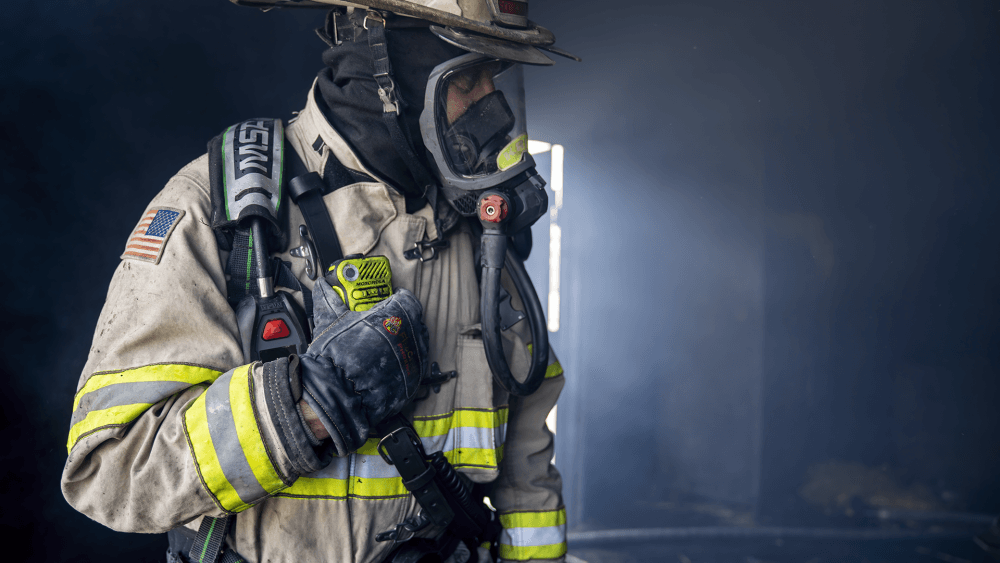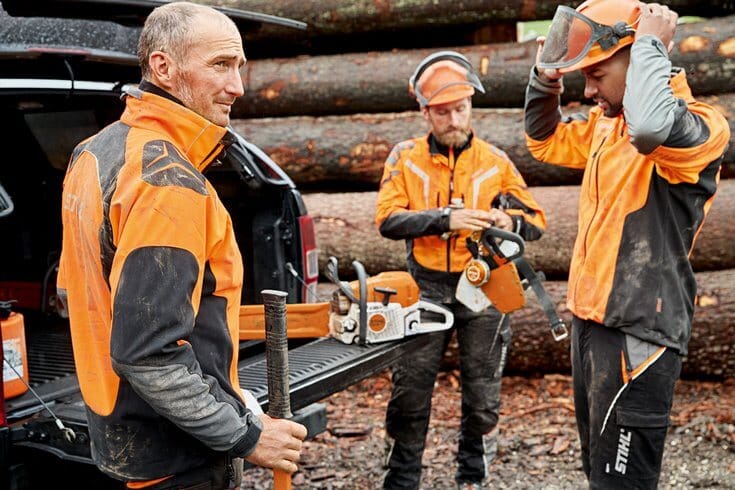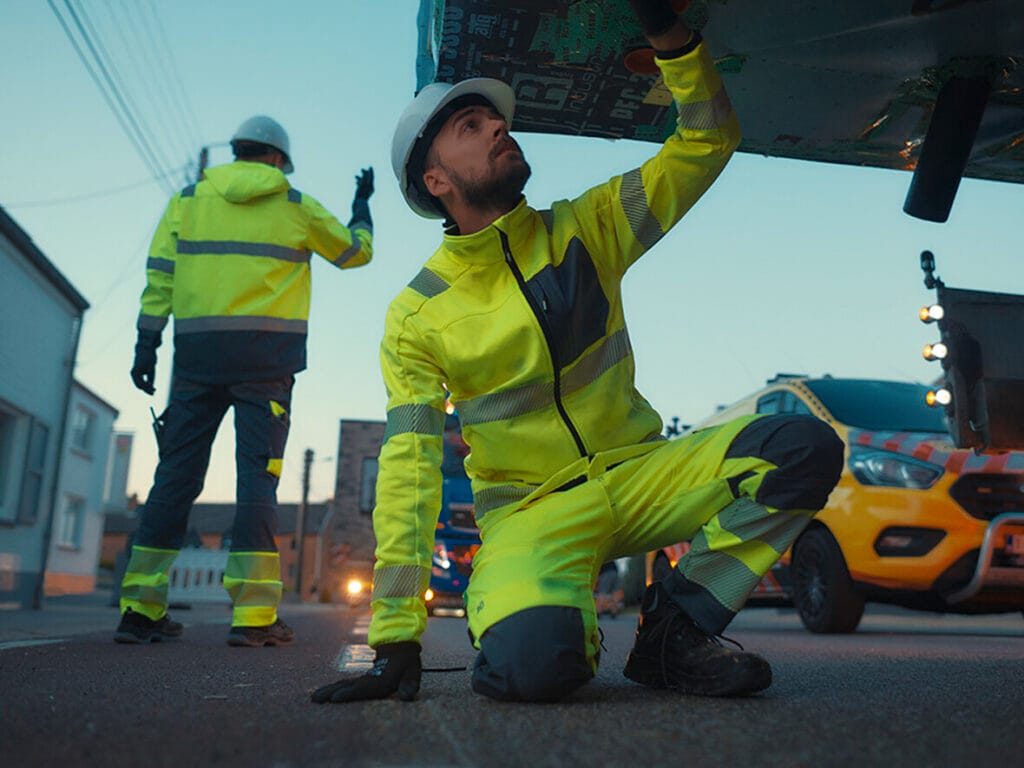
A Comprehensive Whitepaper from the Perspective of China’s Smart PPE Manufacturers
Executive Summary
As global construction, mining, logistics, and manufacturing projects scale up in complexity and geographical reach, worker visibility and real-time safety management have become critical challenges. Traditional PPE focuses on physical protection — helmets, boots, and vests — but in modern high-risk, dispersed sites, knowing where workers are, what they’re doing, and how safely they’re operating is just as essential as protecting them from impact or exposure.
This whitepaper explores how GPS-enabled workwear—smart helmets, vests, and uniforms embedded with IoT tracking systems—enhances safety, accountability, and operational efficiency in large projects. It presents a deep dive into the technology, compliance standards, case studies, and return on investment (ROI) associated with smart PPE, with a special focus on China’s manufacturing ecosystem that powers this global transformation.
Workwear Solutions, as a leading Chinese manufacturer and exporter of PPE and smart workwear, demonstrates how integrating GPS and IoT technologies into traditional protective gear creates a new benchmark for safety management across construction, mining, logistics, and industrial sectors.
1. Introduction: The Evolution from Passive to Intelligent PPE
1.1 The New Era of Worker Safety
Worker protection has evolved from reactive to proactive. Traditional PPE protects workers after an incident occurs — for instance, preventing head or foot injuries. But smart PPE equipped with sensors, GPS, and wireless connectivity can predict and prevent incidents by monitoring location, movement, and environmental conditions in real time.
In a construction site spanning multiple hectares, manual supervision is nearly impossible. Smart helmets and GPS vests can automatically alert managers if a worker enters a restricted zone, remains motionless for too long, or is exposed to excessive temperature or toxic gases.
1.2 Why GPS Is Becoming Core to Modern PPE
While IoT sensors collect data about conditions, GPS provides spatial context — it tells supervisors where each worker is and enables coordination across vast project areas.
In large infrastructure or energy projects, workers are often spread across several square kilometers, sometimes across multiple sites. GPS tracking ensures:
- Immediate response during accidents or health emergencies.
- Efficient assignment of tasks and movement between zones.
- Compliance with safety protocols and restricted area boundaries.
- Historical records for audit, compliance, and insurance verification.
This capability turns PPE from static gear into a dynamic safety network.
2. Technology Overview: How GPS-Enabled Workwear Functions
2.1 Core Components of GPS-Enabled Workwear
| Component | Function | Example Integration |
|---|---|---|
| GPS Module | Tracks real-time worker location | Embedded in helmets, vests, or belts |
| Accelerometer | Detects movement and impact | Triggers alerts during falls or inactivity |
| Temperature Sensor | Monitors heat stress | Used in high-heat zones or cold storage |
| Communication Chip (NB-IoT / LoRa / LTE) | Sends data to cloud platform | Enables real-time monitoring dashboards |
| Battery Module | Powers sensors for 12–48 hours | Rechargeable or replaceable battery units |
| Cloud Platform | Stores and analyzes safety data | Supervisors access via app or desktop |
| Software Interface | Displays maps, alerts, and reports | Used for safety audits and analytics |
Modern GPS-enabled workwear integrates multiple modules within garments, helmets, or boots while maintaining compliance with EN, ISO, or ANSI protective standards.
2.2 IoT Connectivity Standards
Chinese smart PPE manufacturers have become pioneers in low-power wide-area network (LPWAN) adoption, particularly using NB-IoT and LoRa technologies. These allow stable communication even in tunnels, mining shafts, or remote fields, where Wi-Fi or cellular signals are weak.
- NB-IoT: Ideal for nationwide connectivity with low power consumption.
- LoRa: Perfect for private networks within large sites.
- 5G Modules (optional): Used for video streaming or data-intensive applications such as AR helmets.
Workwear Solutions partners with sensor and telecom solution providers to integrate these technologies directly into protective clothing without compromising comfort or durability.
3. Industry Applications: How GPS Workwear Transforms Safety Management
3.1 Construction and Infrastructure
In large-scale bridge, highway, or metro projects, GPS-enabled vests allow supervisors to:
- Track workforce distribution in real time.
- Monitor entry into hazardous or restricted zones.
- Provide automated evacuation routing during emergencies.
Case Example:
A Southeast Asian metro project equipped 1,500 workers with GPS-enabled vests sourced from a Chinese supplier. The system reduced unauthorized zone entries by 72% and emergency response time by 41%, according to the site’s safety audit.
3.2 Mining and Tunneling
Underground worksites pose unique challenges: limited visibility, confined spaces, and lack of connectivity. GPS systems using hybrid positioning (GPS + inertial sensors + LoRa beacons) allow precise localization of miners even below ground.
Smart helmets can trigger distress alerts automatically when no movement is detected for a set period — enabling “man-down” detection and saving lives during collapses or gas leaks.
3.3 Logistics and Warehousing
In logistics parks and container terminals, worker traffic intersects with forklifts and heavy equipment. GPS-enabled vests support geo-fencing, automatically alerting drivers if a worker enters a vehicle’s blind zone.
A European logistics client reported a 60% reduction in near-miss collisions after implementing GPS-vest monitoring across three sites.
3.4 Manufacturing and Industrial Plants
In chemical and heavy manufacturing plants, smart PPE combines GPS with gas detection sensors to protect workers from exposure to harmful vapors. Real-time alerts allow central control rooms to respond instantly.
3.5 Utilities and Energy
Workers maintaining power lines, wind turbines, or pipelines often work in isolated zones. GPS workwear ensures supervisors can locate workers instantly and coordinate rescue if a fall or electrical hazard occurs.
4. International Standards and Compliance
4.1 Relevant PPE Safety Standards
| Category | Standard | Coverage |
|---|---|---|
| Smart Safety Helmets | EN 397 / ANSI Z89.1 | Impact resistance, electrical insulation |
| Smart Vests | EN ISO 20471 | High-visibility protection |
| GPS Electronics | CE / FCC Certification | Electronic communication and emission safety |
| Battery and Power Units | UN 38.3 | Transport safety for lithium batteries |
| Software & Data | GDPR / ISO 27001 | Data privacy and information security |
Chinese manufacturers like Workwear Solutions ensure dual compliance with both European (CE) and North American (ANSI) standards to meet export requirements.
4.2 Data Privacy and Worker Consent
Since GPS tracking involves personal data, it must follow data protection laws. Reputable suppliers provide:
- Encrypted communication channels.
- Access-controlled management dashboards.
- Transparent worker consent policies.
5. The Economic Rationale: ROI of Smart Workwear
5.1 The Cost of Inefficient Safety Management
Worksite accidents, lost time, and poor visibility into workforce movement cost large projects millions annually. For example:
| Incident Type | Average Cost per Case (USD) | Annual Frequency (Typical 1,000-worker site) | Annual Impact (USD) |
|---|---|---|---|
| Slip/fall injury | $8,000 | 15 | $120,000 |
| Lost worker (search/rescue) | $25,000 | 5 | $125,000 |
| Unauthorized entry into hazardous zone | $3,000 | 30 | $90,000 |
| Delays due to poor workforce visibility | – | – | $250,000+ |
These add up to nearly $600,000 annually, excluding reputational or legal risks.
5.2 ROI of GPS Workwear Investment
| Investment Item | Cost (Annual) | Estimated Savings / Benefits |
|---|---|---|
| GPS-Enabled Vests (1000 units @ $45) | $45,000 | $250,000 saved from reduced accidents |
| Smart Helmets (1000 units @ $60) | $60,000 | $180,000 from faster emergency response |
| IoT Platform Subscription | $20,000 | $80,000 productivity gain |
| Total | $125,000 | $510,000+ annual benefit |
ROI: 4.08x within the first year.
6. Common Challenges and Solutions
| Challenge | Impact | Solution Provided by Chinese Manufacturers |
|---|---|---|
| Battery life too short | Downtime and data gaps | Integration of low-power NB-IoT chips and optimized firmware |
| Discomfort or weight | Worker resistance | Lightweight textile integration with modular sensors |
| Connectivity loss in remote zones | Data inconsistency | Hybrid network: GPS + LoRa + offline caching |
| Privacy concerns | Union resistance | Encrypted data, limited access, and anonymized reporting |
| Cost concerns | Budget limits | Scalable deployment starting with high-risk zones |
Workwear Solutions addresses these through R&D partnerships with chip and textile technology providers, ensuring field-tested, export-ready smart PPE solutions.
7. Procurement Guidelines for Project Buyers
7.1 Key Evaluation Criteria
When sourcing GPS-enabled PPE from China, foreign buyers should assess:
- Certification compliance (CE/FCC/ISO)
- Network compatibility (NB-IoT, LoRa, LTE)
- Battery endurance (minimum 24 hours)
- Ease of software integration
- After-sales support and firmware updates
7.2 Supplier Verification Checklist
- [ ] Factory inspection reports
- [ ] Electronic module test reports (CE/FCC)
- [ ] PPE certification (EN, ANSI)
- [ ] Data security documentation (ISO 27001 or equivalent)
- [ ] Sample trial feedback and field test data
7.3 Import & Logistics Considerations
For global buyers:
- Lithium battery shipping must follow UN 38.3 certification.
- Customs declarations should include “smart protective equipment” (HS Code 9029 or 6210).
- For EU importers, verify CE conformity documentation.
8. Case Studies from China’s Smart PPE Export Ecosystem
Case 1: Large Construction Group in the Middle East
A Chinese supplier equipped a 3,000-worker oil refinery project with GPS-enabled vests. The platform reduced unaccounted man-hours by 28% and allowed real-time compliance with confined space entry permits.
Case 2: Logistics Park in Eastern Europe
Through a partnership with Workwear Solutions, a Polish logistics operator implemented smart vests with proximity sensors. Within six months, near-miss incidents between forklifts and workers dropped by 63%.
Case 3: Underground Mining Operation in South America
Using hybrid GPS + inertial tracking helmets, miners could be located within 2 meters even without direct satellite signals. Emergency response time decreased from 40 minutes to 12.
9. The Strategic Role of China’s PPE Manufacturers
9.1 Integration of Textiles, Electronics, and IoT
China’s supply chain combines advanced textile engineering with electronics manufacturing and IoT platform development—a synergy few countries can match.
Factories like those under Workwear Solutions leverage partnerships with chip producers in Shenzhen, fabric suppliers in Jiangsu, and IoT software developers in Hangzhou to deliver turnkey solutions.
9.2 Cost and Scale Advantages
Due to production efficiency and vertical integration, Chinese smart PPE can offer 20–40% lower costs than comparable Western products while maintaining certification compliance.
9.3 Export Support and Customization
Manufacturers offer multilingual interfaces, localized data hosting, and customized branding options for distributors, allowing partners in Canada, Vietnam, and Europe to rebrand products under their own labels.
10. The Future of GPS Workwear: Toward Predictive Safety
10.1 Data-Driven Prevention
The next stage of smart PPE is predictive analytics. By analyzing movement patterns and stress data, AI can identify fatigue or unsafe behaviors before accidents occur.
10.2 Integration with Enterprise Systems
GPS data will soon synchronize with project management and HR software, enabling automatic attendance logging and performance tracking.
10.3 Sustainability and Circular Design
As global buyers demand eco-friendly production, smart PPE manufacturers are shifting to recyclable fabrics, modular electronics, and energy-efficient charging systems.
10.4 Regulatory Outlook
The EU and US are expected to introduce smart PPE guidelines by 2026, mandating digital traceability and location-aware safety systems for large industrial projects.
11. Buyer’s FAQ
Q1: Can GPS workwear operate offline?
Yes, data is cached locally and synced when signal returns, using LoRa or Bluetooth relay systems.
Q2: How long do batteries last?
Depending on module type, between 18 and 48 hours continuous tracking.
Q3: Are these garments washable?
Yes, sensors are modular and detachable before cleaning.
Q4: What if my project site lacks 4G coverage?
Manufacturers offer LoRa-based private networks with base stations for isolated sites.
Q5: What is the lead time for mass orders?
Typically 45–60 days for bulk orders, including customization and certification validation.
12. Conclusion
GPS-enabled workwear represents the next evolution in industrial safety — combining traditional PPE protection with real-time situational awareness.
From construction and mining to logistics and manufacturing, these technologies reduce accidents, increase accountability, and streamline workforce management.
As this whitepaper demonstrates, China’s PPE manufacturers, led by companies like Workwear Solutions, are at the forefront of making this transformation global.
By integrating textiles, electronics, and cloud platforms, they provide international buyers with certified, scalable, and cost-effective smart PPE solutions.
About Workwear Solutions
Workwear Solutions is a professional PPE and smart workwear manufacturer based in China.
With a focus on innovation, compliance, and customization, the company exports to over 20 countries across Europe, North America, and Asia.
Its portfolio includes high-visibility clothing, protective coveralls, insulated garments, and IoT-integrated smart PPE.
🌐 Website: www.workwearsolutions.net
📩 Email: [email protected]
Empowering Safety. Connecting People. Building Smarter Workplaces.
Zion Zhang
Recent Posts
 For Emerging Markets: How to Introduce Smart PPE Without High Cost2025年11月13日Emerging markets across Asia, Africa, the Middle East, and […]
For Emerging Markets: How to Introduce Smart PPE Without High Cost2025年11月13日Emerging markets across Asia, Africa, the Middle East, and […] Case Study: How Qatar Construction Sites Used Smart Workwear for World Cup Projects2025年11月12日The construction of Qatar’s 2022 FIFA World Cup […]
Case Study: How Qatar Construction Sites Used Smart Workwear for World Cup Projects2025年11月12日The construction of Qatar’s 2022 FIFA World Cup […] The Cost-Benefit of Smart PPE: When Safety Becomes ROI2025年11月10日In today’s industrial landscape, safety is no longer just […]
The Cost-Benefit of Smart PPE: When Safety Becomes ROI2025年11月10日In today’s industrial landscape, safety is no longer just […] Heart Rate, Heat & Fatigue Sensors: Monitoring Workers in Real Time2025年11月7日In high-risk industries such as construction, mining, […]
Heart Rate, Heat & Fatigue Sensors: Monitoring Workers in Real Time2025年11月7日In high-risk industries such as construction, mining, […] Smart Helmets and Vests: How IoT is Preventing On-Site Accidents2025年11月7日Smart Personal Protective Equipment (PPE) is redefining […]
Smart Helmets and Vests: How IoT is Preventing On-Site Accidents2025年11月7日Smart Personal Protective Equipment (PPE) is redefining […] The Peruvian Entrepreneur Who Turned PPE Into a Family Business2025年10月31日Starting Point: A Small Shop Run by a Couple In the […]
The Peruvian Entrepreneur Who Turned PPE Into a Family Business2025年10月31日Starting Point: A Small Shop Run by a Couple In the […]
CONTACT US
- Feel free to contact us any time. We will get back to you as soon as we can!
- +86-17303331701
